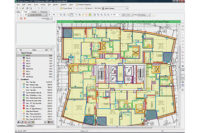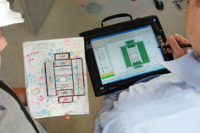Centered on Solutions
How Technology Wins Claims

In a perfect world, every construction job runs smoothly; there are never delays, everything is done in sequence and contractors make the profit, or better their estimates. Unfortunately construction projects are rarely perfect. Material shipments are late, incomplete or just plain wrong. Other trades can fall behind in their work, causing delays for the crew. Schedules can be broken and even the weather can affect the project. All these situations can lead to claims, which put undue stress on the project and the team. The key to success in a claim situation is effective documentation that begins when the project starts, and provides access to data gathered during the project’s entire lifecycle. Utilizing best practices and strategic project management in conjunction with these technologies can help a contractor stack the odds of successfully defending against a claim in their favor. Here’s what you need to know.
There are a lot of reasons why contractors don’t seem to worry about the claims process. Some of the most often cited are:
- Claims happen to the “other guy.”
- Projects are always fully documented.
- Projects always go according to plan.
- Communication never breaks down.
- The numbers aren’t always trustworthy.
The need to file claims can put stress on the project and the team. It is better to go on the offensive with up-front strategic project management in order to be prepared for claims. Best practices won’t eliminate or prevent a claim, they will, however, put the contractor in a stronger and more defensible position and potentially win the claim outright.
Strategic Project Management
The process for managing the data in a project technically starts during the takeoff process. Digital takeoff solutions that integrate with bidding and project management solutions will create a trackable archive of data that may be necessary to defend against a claim. Understanding how these technologies operate and work together will allow construction professionals to abandon paper trails for digital trails. The commitment to adopt technology for all stages of a project will make data more accessible and trackable.
Project managers are responsible for tracking a great deal of information in any construction project. It is equally important to perform analytics on this data; and the adoption of synergistic technology solutions makes this task much easier. Project managers must track original estimated quantities of materials and labor hours. They must measure the installed materials and the corresponding completed labor hours. This includes the percentage completed to the calculated earned value. The inclusion of actual payroll data brings a higher level of accuracy to the project that helps determine its success or failure.
There are five essentials to strategic project management that collectively make up the best practices. These are scope, resource, time, money and documentation. Technology solutions that work together and provide takeoff, bidding and project management collectively cover and enable these best practices.
Scope is the first essential, and can be thought of as the quantitative takeoff. It forms the basis for good project documentation. Takeoff is the visualization of what has been defined as the project’s scope of work. It is the job’s benchmark and each project manager should perform their own takeoff after winning the bid, before starting the build. Manual takeoffs are known for errors that can show up as profit loss at the end of a project. An automated takeoff improves accuracy and increases speed, thereby saving labor costs, as well.
Resource refers to the labor and material budget. It is critical to be thorough and break down everything by area and code. The breakdown should reflect how the job will be manned and sequenced. Confirmation of this workflow should be made with the foreman. The stocking list should also reflect the area and code breakdown. This information is evidence of what was planned to be done by the contractor before any circumstances on the job changed. This is the basis for planned versus actual material tracking. The value of an automated bidding software solution that maintains all the data during the life cycle of a project, and enables factors like current pricing and trade specific databases, becomes clear when considering resource management.
Time is something typically “given” to contractors by the GC and is the schedule that subs live or die by. Considerations include whether the schedule of tasks outlined matches the sequence in which the crews need to work. It is important to identify vertically stacked activities to indicate potential conflicts or areas of concern. This involves proactive resource loading. Activities like calculating man hours against budgeted activities and understanding how to balance resources are cumbersome to calculate manually and may not provide an accurate picture of labor costs against line items. Digital solutions quickly compare labor rates and costs, clarify project scope, monitor time and money, document the project, and feed that data back into a loop to improve future bidding.
Money
Contractors need a solid job cost accounting system in order to manage money. Estimated quantities must be identified from the digital takeoff performed by the project manager before beginning the build. In addition, the installed data quantities should be gathered from the job site using automation tools that will instantly communicate back to the office. The next step is to align that information to the weighted average, then combine it with the estimated time versus the actual time. Collectively this data analysis yields the calculation of the completed percentage of the job. Projections for the final costs will show potential claims based on this information. Understanding where the project stands, along the complete project lifecycle, allows critical changes to be made before the project is complete and it’s too late. Digital production control software allows for this tracking and job transparency.
Documentation is arguably the most important of the five essentials. As stated at the outset of this article, documentation must be started from the beginning, not when a problem arises. Relying on what the “crew remembers” or digging around piles of paper or spreadsheets distributed across multiple devices is unreliable and dangerous. A shortfall of evidence can lead to a “your word against theirs” scenario when it comes to supporting or defending a claim. Digital solutions provide for accurately tracking the measured mile, and in a manner that can be quickly accessed. Automated tools that provide time stamping of work associated with progress can help when dealing with factors that cause issues like cost overruns. Additional supporting evidence includes the ability to store photos and videos that can be quickly called up in the case of an argument.
Dealing with claims can quickly become a time consuming distraction without proper documentation. With the powerful technology solutions now available, the process of filing a claim to avoid losing money or to recover money can be managed in a manner that does not distract from the core business: construction. Strategic and proactive project management will not prevent claims, but will provide the tools to increase the odds of winning them.
Looking for a reprint of this article?
From high-res PDFs to custom plaques, order your copy today!






